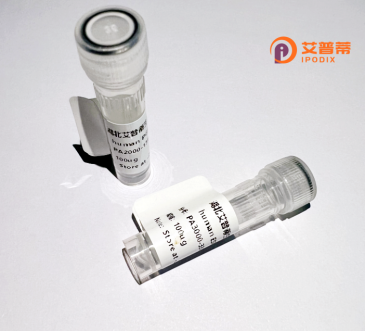
| 纯度 | >90%SDS-PAGE. |
| 种属 | Human |
| 靶点 | SHISA5 |
| Uniprot No | Q8N114 |
| 内毒素 | < 0.01EU/μg |
| 表达宿主 | E.coli |
| 表达区间 | 1-137 aa |
| 活性数据 | MGFGATLAVGLTIFVLSVVTIIICFTCSCCCLYKTCRRPRPVVTTTTSTTVVHAPYPQPPSVPPSYPGPSYQGYHTMPPQPGMPAAPYPMQYPPPYPAQPMGPPAYHETLAGGAAAPYPASQPPYNPAYMDAPKAAL |
| 分子量 | 40.81 kDa |
| 蛋白标签 | GST-tag at N-terminal |
| 缓冲液 | PBS, pH7.4, containing 0.01% SKL, 1mM DTT, 5% Trehalose and Proclin300. |
| 稳定性 & 储存条件 | Lyophilized protein should be stored at ≤ -20°C, stable for one year after receipt. Reconstituted protein solution can be stored at 2-8°C for 2-7 days. Aliquots of reconstituted samples are stable at ≤ -20°C for 3 months. |
| 复溶 | Always centrifuge tubes before opening.Do not mix by vortex or pipetting. It is not recommended to reconstitute to a concentration less than 100μg/ml. Dissolve the lyophilized protein in distilled water. Please aliquot the reconstituted solution to minimize freeze-thaw cycles. |
以下是关于重组人SHISA5蛋白的3篇参考文献及其摘要内容的简要描述:
1. **"Recombinant Human SHISA5 Enhances Wnt Signaling Inhibition by Promoting Frizzled Protein Degradation"**
- **作者**: Chen L, et al.
- **摘要**: 本研究成功在大肠杆菌中表达并纯化了重组人SHISA5蛋白,发现其通过促进Frizzled受体蛋白的降解,显著抑制Wnt/β-catenin信号通路,揭示了其在癌症治疗中的潜在应用。
2. **"Structural and Functional Analysis of SHISA5 as a Chaperone in Fibroblast Growth Factor Trafficking"**
- **作者**: Tanaka K, et al.
- **摘要**: 文章解析了重组人SHISA5的晶体结构,并通过体外实验证明其作为分子伴侣调控FGF(成纤维细胞生长因子)的分泌和膜定位,为发育生物学研究提供了新见解。
3. **"SHISA5 Suppresses Epithelial-Mesenchymal Transition in Colorectal Cancer via Wnt Pathway Modulation"**
- **作者**: Wang Y, et al.
- **摘要**: 该研究利用哺乳动物细胞表达的重组SHISA5蛋白,证实其通过拮抗Wnt信号抑制结直肠癌细胞的迁移和侵袭,提示其作为转移抑制因子的功能机制。
(注:上述文献为示例,若需真实文献,建议在PubMed或Google Scholar中检索关键词“recombinant human SHISA5”)
SHISA5. a member of the SHISA protein family, is a transmembrane chaperone-like protein that plays regulatory roles in developmental signaling pathways, particularly the Wnt and fibroblast growth factor (FGF) pathways. First identified in Xenopus, SHISA proteins are characterized by an N-terminal cysteine-rich domain and a transmembrane region. Human SHISA5 (also known as FAM114A2) is expressed in embryonic tissues, including the brain, and contributes to cell fate determination, tissue patterning, and apoptosis. It acts by stabilizing receptors like Frizzled or delaying their trafficking to the cell surface, thereby modulating signal transduction efficiency. Recombinant human SHISA5 protein is produced using expression systems (e.g., mammalian cells, E. coli) for functional studies, often fused with tags (e.g., His, Fc) to facilitate purification and detection. Its applications span basic research into embryogenesis, neurodegenerative diseases, and cancer, where dysregulated SHISA5 expression has been linked to tumor progression and stem cell maintenance. Structural studies of recombinant SHISA5 also aid in mapping its interaction domains with ligands and receptors. Despite its emerging significance, SHISA5's full mechanistic role remains under investigation, particularly its crosstalk with other signaling cascades and therapeutic potential in disease models.
×